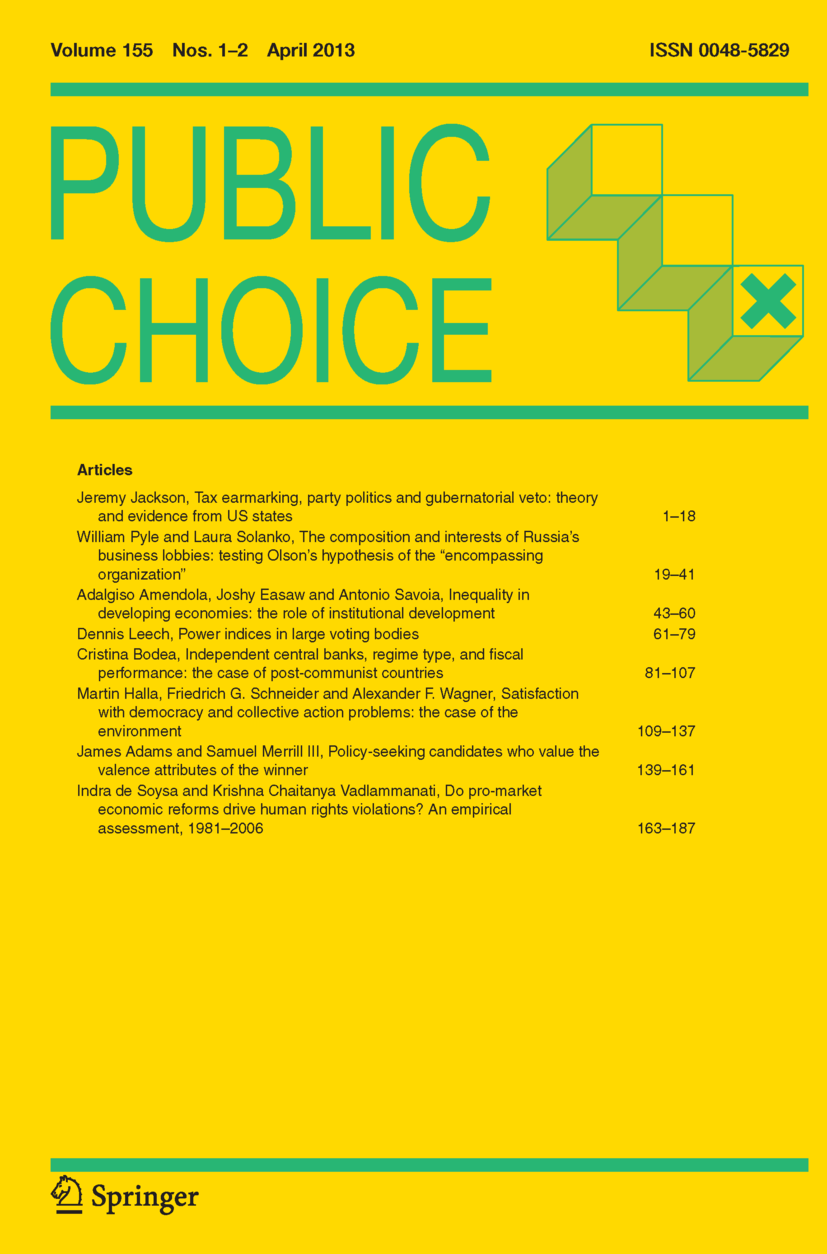link.springer.com/10.1007/s11127-010-9707-5
Preview meta tags from the link.springer.com website.
Linked Hostnames
19- 28 links tolink.springer.com
- 15 links toscholar.google.com
- 12 links todoi.org
- 10 links towww.springernature.com
- 2 links tocitation-needed.springer.com
- 2 links toscholar.google.co.uk
- 2 links tosupport.springernature.com
- 2 links towww.ncbi.nlm.nih.gov
Thumbnail

Search Engine Appearance
https://link.springer.com/10.1007/s11127-010-9707-5
A comparison of cumulative voting and generalized plurality voting - Public Choice
In market based societies consumers are able to express the intensity of their preference for an object by paying more for it. However, under some voting s
Bing
A comparison of cumulative voting and generalized plurality voting - Public Choice
https://link.springer.com/10.1007/s11127-010-9707-5
In market based societies consumers are able to express the intensity of their preference for an object by paying more for it. However, under some voting s
DuckDuckGo
A comparison of cumulative voting and generalized plurality voting - Public Choice
In market based societies consumers are able to express the intensity of their preference for an object by paying more for it. However, under some voting s
General Meta Tags
84- titleA comparison of cumulative voting and generalized plurality voting | Public Choice
- charsetUTF-8
- X-UA-CompatibleIE=edge
- applicable-devicepc,mobile
- viewportwidth=device-width, initial-scale=1
Open Graph Meta Tags
6- og:urlhttps://link.springer.com/article/10.1007/s11127-010-9707-5
- og:typearticle
- og:site_nameSpringerLink
- og:titleA comparison of cumulative voting and generalized plurality voting - Public Choice
- og:descriptionIn market based societies consumers are able to express the intensity of their preference for an object by paying more for it. However, under some voting systems, consumers are unable to express the intensity of their preference for a candidate due to the constraint of the “one person, one vote” principle. Cumulative voting maintains the equality of the “one person, one vote” principle by allotting each voter the same number of votes, while also allowing for expression of intensity of candidate preference. This paper provides an experimental analysis of voter behavior under different voting systems.
Twitter Meta Tags
6- twitter:site@SpringerLink
- twitter:cardsummary_large_image
- twitter:image:altContent cover image
- twitter:titleA comparison of cumulative voting and generalized plurality voting
- twitter:descriptionPublic Choice - In market based societies consumers are able to express the intensity of their preference for an object by paying more for it. However, under some voting systems, consumers are...
Item Prop Meta Tags
3- position1
- position2
- position3
Link Tags
9- apple-touch-icon/oscar-static/img/favicons/darwin/apple-touch-icon-6ef0829b9c.png
- canonicalhttps://link.springer.com/article/10.1007/s11127-010-9707-5
- icon/oscar-static/img/favicons/darwin/android-chrome-192x192.png
- icon/oscar-static/img/favicons/darwin/favicon-32x32.png
- icon/oscar-static/img/favicons/darwin/favicon-16x16.png
Emails
1Links
84- http://scholar.google.com/scholar_lookup?&title=Behind%20the%20ballot%20box%3A%20a%20citizen%E2%80%99s%20guide%20to%20voting%20systems&publication_year=2000&author=Amy%2CD.
- http://scholar.google.com/scholar_lookup?&title=Centripetal%20and%20centrifugal%20incentives%20in%20electoral%20systems&journal=American%20Journal%20of%20Political%20Science&doi=10.2307%2F2111465&volume=34&pages=903-935&publication_year=1990&author=Cox%2CG.
- http://scholar.google.com/scholar_lookup?&title=Cumulative%20and%20plurality%20voting%3A%20an%20analysis%20of%20Illinois%E2%80%99%20unique%20electoral%20system&journal=Western%20Political%20Quarterly&doi=10.2307%2F447147&volume=26&pages=726-746&publication_year=1974&author=Kuklinski%2CJ.
- http://scholar.google.com/scholar_lookup?&title=Game%20theory%20and%20cumulative%20voting%20for%20corporate%20directors&journal=Management%20Science&doi=10.1287%2Fmnsc.5.2.151&volume=5&pages=151-156&publication_year=1959&author=Glasser%2CG.%20J.
- http://scholar.google.com/scholar_lookup?&title=Game%20theory%20and%20cumulative%20voting%20in%20Illinois%3A%201902%E2%80%931954&journal=American%20Political%20Science%20Review&doi=10.2307%2F1952795&volume=56&pages=936-946&publication_year=1962&author=Sawyer%2CJ.&author=MacRae%2CD.